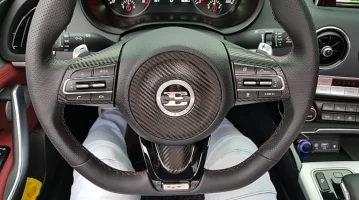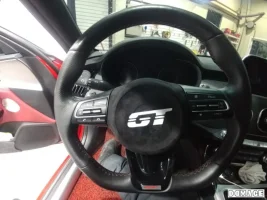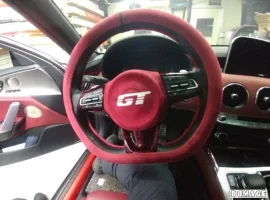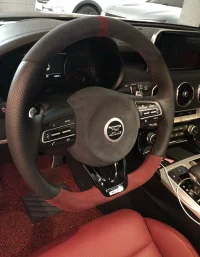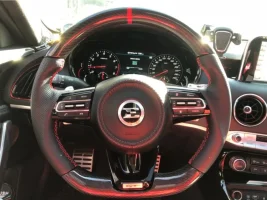In particular, I was quite disappointed to see the extremely hard, cheap, low quality plastics that were used for the center of the steering wheel and the bottoms of the interior of the doors. When you've already put so much into the rest of the car, the amount of money you've saved by skimping on these plastics has to be absolutely minuscule and I feel like you're loosing far more in perceived value than you are gaining in money saved on production. The only areas where I would consider it to be acceptable to use such low end materials would be places that people are rarely looking at or touching, such as the hunks that cover the lower B pillar.
The bigger issue is the steering wheel/air bag cover (more on that later), but one can find hard plastics down below on the 3 Series (may be diff. for the new 3er), IS, ATS, XE, etc.
the hard plastic on the doors is pretty much a given at this price point. Under 40/50k you won't find soft touch materials that low on the door. As another user explained, this is pretty much a wear area and its easier to wipe a scuff off hard plastic than replace a gashed piece of trim that is upholestered or soft touch. Maybe you might have a felt liner on the inside of the map pocket. The steering wheel hub on the other hand should have been rubberized at the least.
Agree.
The Phaeton failed because it was too much of a price increase for Volkswagen buyers AND it was too similar to the Audi A8. Hyundai and Kia need to make sure their products are significantly different and not priced sky-high
Yep, was priced too close to the A8 (only a few thousand cheaper) and looked like an oversized Passat.
There's a few things they could have done better. The plastics of the turning knobs for the mode/dampers or others feel thin and cheap. That's not something costing a lot for Kia, but making a much better impression, if they had done it right etc. And like mentioned before somewhere, putting a bit of hollow sounding hard plastic right in your face (aka steering wheel pot) ist just a "WTF did you do there, Kia?!".
While I agree that all the switchgear (and other touchpoints such as the door release and
paddle shifters) should be made of quality materials (meaning none of that silver-painted plastic crap), it comes down to price and how much Kia can spread the cost of new parts.
Unfortunately, the Stinger and K9/K900 are relatively low volume vehicles, so w/o other luxury models added to Kia's lineup, Kia wouldn't get the economies of scale to justify such added cost.
Had the same complaints about the Genesis/
G80.
But note that for the
G70, all the parts that look metal are made of metal (in many ways, the interior of the
G70 is nicer than the
G80 - which will remain the case until the
G80 is replaced w/ the new model).
Genesis has an 8 or 9 model line-up planned, so the the cost-benefit is much more favorable (H and K, aside from shared major components, tend to go their own way, but in this case, wouldn't hurt if Kia asked Genesis to supply them w/ the higher quality switchgear).
I'll never understand why something that may cost a few dollars more, per car, can't just be added onto the price of the vehicle. What's another $5 or $10 going to do when the car you're buying is $40k or $50k? Do executives feel that could be a deal breaker?
It all has to do w/ volume/economies of scale.
Heck, the Maserati Quattroporte has things from the Chrysler parts bin and that's several price-points above the Stinger.
For a $100k+ car, that's simply an embarrassment (the Quattroporte has also gotten dinged for cheap plastics in the interior).



